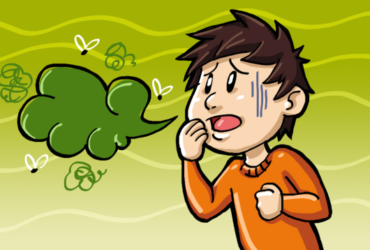BY: MACKENZIE HANNUM
Do you realize that you make around 200 decisions about food per day [1]? And for all of those decisions there are lots of subtle influences that impact your final liking of the food product — some you may not even notice. Overall, the idea is that what we prefer to eat is based on much more than flavor alone. Rather, liking is a multi-sensory act in which all of our senses can influence our final perception of food [2]. This article will explain some of those fundamental influences through the help of the beloved Michelle Tanner from the television series Full House.
Branding and Labeling Influence
If the packaging looks cool it has to taste cool too, right? Most of the time our liking of a food is influenced before we even take the first bite. The packaging and visual appearance create expectations and can influence how we perceive a product. In one study consumers’ eye-movements were tracked while evaluating packaging prior to their determination of the products’ perceived healthfulness and willingness to pay for the products. A great majority of consumers fixated their gaze on four areas of the products: image, brand, ingredients, and nutritional information [3]. This suggests we are already differentiating products before we take a taste of them. Ever heard the saying “never judge a book by its cover”? It looks like when we eat, we are doing just that…

https://68.media.tumblr.com/3ab0886ab68b20aedd693752474d19c1/tumblr_nhai2ayQJa1u6eageo1_500.gif
Language Influence
Ever read a menu and wondered why they use specific words? Why do menus at expensive restaurants write a paragraph describing the entrée, whereas cheaper restaurants just state the title of the dish? What about two restaurants that have a similar menu? Have you ever considered a menu might subtly influence what you choose to have for dinner? Dan Jurafsky, a Linguistics professor at Stanford wrote a book investigating just this, called, The Language of Food: A Linguist Reads the Menu. In his book he looked at over 650,000 dishes in 6,500 different menus, and statistically controlled for the type of food, ethnic cuisine, how expensive the restaurant was, location, and analyzed the impact of words on price. Jurafsky discovered that when a restaurant uses longer words to describe a dish it charges more for that dish. Additionally, the use of words like “exotic” or “spicy” also results in a price increase [4]. So next time you’re perusing the menu at your favorite restaurant, think about the words the restaurant uses to describe a particular food and compare it to other items offered.

Environmental Influence
Studies show that the environment you are in can also impact how you perceive a product [5]. Having a hot dog in a baseball stadium might taste different than if you had that same hotdog on a lunch tray in a dingy cafeteria. I recently experienced this phenomenon of environmental impact while traveling abroad. Basically I felt like Michelle Tanner, in my brand new sunglasses, on top of the world.
On my group’s last night in Zurich, we decided to treat ourselves to some true Swiss fondue. Walking into the dimly lit restaurant packed with people speaking in a foreign language, my nose was consumed with smells from the fondue. We ended up accidentally ordering three times the amount of fondue than we anticipated due to the language barrier, but nonetheless we happily ate it all. With wine glasses in hand, we dipped our bread and meat pieces in the fondue, and raved about the food all night long. It was an experience unlike any other, but it made me think…would I be reacting the same way if I was in Columbus, OH at The Melting Pot restaurant? If I took this exact same dinner and stripped away all the context surrounding it, would I still like it as much as I did in Zurich? The amount to which the environment actually impacts liking and even willingness to pay for a product was recently investigated in a study about “natural” labels. Consumers were placed in the Virtual Reality Immersion Laboratory at The Ohio State University and were asked to rate a peanut butter product. Even though the peanut butter product was the same in all conditions consumers were willing to pay more when there was a server on the video screen who talked about the various ingredients and benefits of the product [6]. It just goes to show there is more at play when one buys a product than solely taste and flavor.

https://media.tenor.co/images/cf4cc7db45b131d3a0b2bd9db4f72dae/raw
Price Tag Influence
Another factor implicated in influencing your perception of a product is the price tag, which is highly controlled by the current market rather than the developer or who makes the product. Have you ever wondered if that $50 bottle of wine is reallyyyyy better than the $20 bottle? Duke researcher, Robert Ashton, conducted a sensory study with wine enthusiasts (i.e. those who enjoy drinking and tasting wine) and had them do a blind tasting of numerous wines that varied in price [7]. He confirmed that price tag and hedonic liking of a wine were not correlated, and therefore a higher price did not predict higher liking scores of the wines. So next time you are debating between a cheaper or a more expensive option, you might think twice whether the splurge is worth it.

https://media.giphy.com/media/9fe0KuBPHax9e/giphy.gif
Conclusion
In conclusion, more than taste alone can influence the liking of a product. There are more hidden influences on our decision process than we can even imagine. The purpose of this article is to stretch your mind, make you reconsider the things you might take for granted, and ultimately to provide a better understanding of yourself and what influences your daily food decisions. At the end of the day, we, as humans, are extremely complex and it’s going to take a lot more research to discover all the subtle influences impacting our food preferences.

References
- Wansink B., Sobal J. (2007). Mindless Eating: The 200 Daily Food Decisions We Overlook. Environment and Behavior. 39(1):106-123.
- Spence, C. (2015). Multisensory Flavor Perception. Cell, 161: 24-35.
- Ares, G., Gimenz, A., Bruzzone, F., Vidal, L., Antunez, L., & Maiche, A. (2013). Consumer visual processing of food labels: results from an eye-tracking study. Journal of Sensory Studies, 28(2): 138-153.
- Jurafsky, D. (2014) The Language of Food: A Linguist Reads the Menu. New York, New York: W. W. Norton & Company, Inc.
- Bangcuyo, R.B., Smith, K.J., Zumach, J.L., Pierce, A.M., Guttman, G.A. & Simons, C.T. (2014). The use of immersive technologies to improve consumer testing: The role of ecological validity, context and engagement in evaluating coffee. Food Quality and Preference, 41, 84-95.
- Liu R, Hooker NH, Parasidis E and Simons CT, “A natural experiment: using immersive technologies to study the impact of “all-natural” labeling on perceived food quality and liking.” Journal of Food Science: Sensory and Food Quality (Fast Track) 82 3 (2017) 825-833.
- Ashton, R. H. (2015). Price, prestige and the sensory perception of underdog wines. Wine and Viticulture Journal. 30(1): 63-66.






Leave a Reply